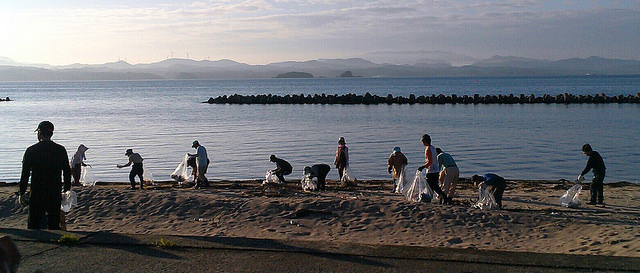
The ocean is filling up with plastic every day, amounting to an unquantifiable number. Predictions have ranged from several hundred thousand tonnes to 100 billion tonnes of plastic, stuck in the 5 ocean vortexes, known as gyres. Many scientists and entrepreneurs have taken on the challenge to devise a plan in cleaning up the oceans; one of note has been the young Dutch inventor, Boyan Slat.
In 2012, Slat presented his idea on TEDx talks, to clean up the oceans and in a staggering time frame. His idea, titled the Ocean Cleanup Project, sets out to tackle not just larger plastics such as bottles and nets, but also the smaller particles that have degraded in our oceans; with the achievement to be completed within a 10-year timeframe. Slat experimented using finely meshed trawler nets to collect plastic, since his study found micro-plastics to be 40x more abundant than larger plastics. Using the results from his study, he designed a concept of technology that uses the ocean currents and wind – and coined the phrase “why move through the oceans, if the oceans can move through you?”
The idea is to build an artificial coastline in the center of the garbage patches. This “coastline” will be built using solid screens that catch plastic particles. The V shaped design on the structure will allow the plastic to be pushed and collected into the center, which will then be extracted every 5 weeks and brought back to land for recycling.
Despite establishing a considerable amount of online enthusiasm for the project, there are many flaws and setbacks that impose on the project. Many oceanographers and biologists question its ability to tackle the issue. For example, experts are unsure whether the design will survive the natural forces in the open ocean, and if it does, will it have a negative impact on sea life?
Slat, in response to these concerns, stated: “The thing is, what we’re trying to achieve has never been done before.”
“It’s 100 times bigger than anything that’s ever been deployed in the ocean. It’s 50% deeper, and 10 times more remote than the world’s most remote oil rig. So obviously there [are] technical challenges.”
During the 2014 summer, Slat and his team released a 528-page feasibility study to determine whether the project was possible. The study focused on four possible designs, but Slat states that they are still working on finalizing a design of the collection platform.
As lengthy as the study is, scientists are still unconvinced of the potential success of the project, with the main concerns still largely unaddressed. Kim Martini, a biological oceanographer, wrote in an email:
“We continue to have serious reservations about the success of the project due to the quality of the responses [to our review] that we could find, and [to] the Ocean Cleanup’s substantive misinterpretation of oceanography, ecology, engineering and marine debris distribution, all of which are necessary for this project to succeed.”
Martini voiced his concerns, saying that the project greatly underestimates open ocean forces. Although Slat has stated that marine fauna can pass underneath the structure, it doesn’t take into account buoyant organisms such as velella or purple janthina snails. Biofouling would also be a huge concern – an issue also not addressed.
Slat is undeterred, however. “The ocean garbage patches won’t disappear by themselves,” he says. “If you collect plastic closer to the source, the total mass that you remove may be larger, and the influx to the gyres would be reduced. Our focus however is on the necessary task of removing the plastic that already reached the gyres.” Slat’s next steps are to take his team and deploy a prototype in the North Sea. A 100-meter structure about 1/1000th of the planned size, will be set up 20km off shore.
We can all agree that we want to see the oceans cleaned up. We can all contribute to the reduction of ocean plastic through simple daily changes, from as little as reducing or completely stopping the use of cosmetics that contain microbeads. If you live by the coast, get involved in a beach clean-up; refuse a plastic bag at the supermarket; and finally, reduce, reuse and recycle!
Source: Flickr, Day Donaldson (CC.BY.2.0)
You want to support Anonymous Independent & Investigative News? Please, follow us on Twitter: Follow @AnonymousNewsHQ
This article (Is There a Way to Truly Eradicate Plastic from the Oceans?) is a free and open source. You have permission to republish this article under a Creative Commons license with attribution to the author and AnonHQ.com.





